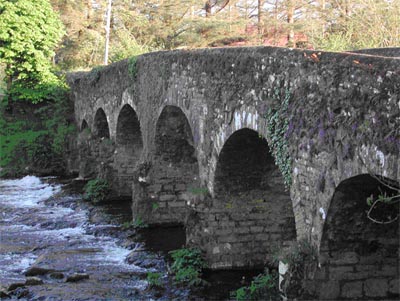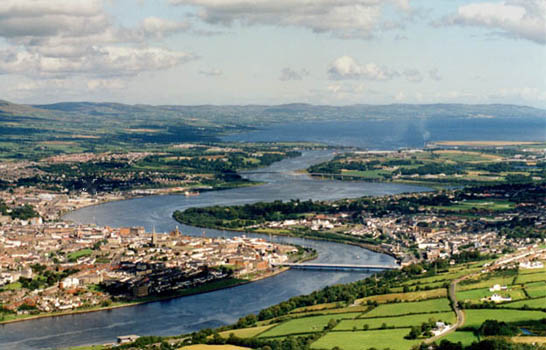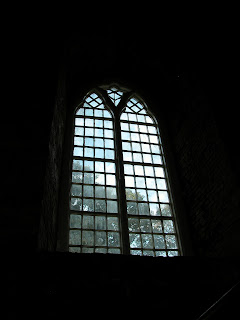Donegal (Sligo)
We stopped in Derry at a shopping center--first one we've seen throughout the whole trip. Londonderry, also known as Derry, is the only remaining completely walled city in Ireland and one of the finest examples of Walled Cities in Europe. The Walls were built during the period 1613-1618 by the honourable, the Irish Society as defences for early seventeenth century settlers from England and Scotland.
 |
| Representing Protestants and Catholic hands almost touching in peace |
 |
| Add caption |
There are nothing like our shopping experience in the US at all in Ireland. You have to wonder how people in the country make it without those staple items. We check the import shop in Donegal for wines and chocolates...bought a bottle for when we get to the hotel. Also checked shoes for Jim and sweaters. We had a couple more places to shop on the tour and the prices might be better as well. Our next shop was Magee Tweed shop and demonstration--we missed the demonstration. Jim is looking for a good wool jacket. They split us into two groups because the weaving studio was very small and could only fit half our group. The second group was called earlier than they told us to meet--we were in the second group. It was just as well...it wasn't that good we heard. Meanwhile, I found a beautiful cashmere/merino wool aran crafts sweater/hoodie Made in Ireland. Haven't seen that style in any of the shops yet. I think I found a winner! Our next stop was the Belliek Factory tour.
You could hardly believe your eyes that the countryside was so beautiful with so much lush land and old bridges. These photos are Donegal
I mean.... Who would believe us??
Donegal is situated in the north-west of Ireland and is surrounded by the Atlantic Ocean to the west; Counties Derry, Tyrone and Fermanagh to the east and Counties Leitrim and Sligo to the south.
The County has six hundred and fifty kilometres of rugged coastline with many sheltered bays
and Blue flag beaches.
Dún na nGall is Irish for *fort of the foreigner*, so called from having repelled the numerous Viking raids on the County in the 8th and 9th centuries.
Donegal is one of the least populated Counties in Ireland with only 146,000 inhabitants. The West of the County contains the largest Gaeltacht (Irish speaking district) in Ireland and Malin Head, Ireland's most northernly point, is situated in the Inishowen peninsula of County Donegal.
While we were traveling, Donegal won their second All-Ireland Football Championship title in a wave of emotion at Croke Park, beating Mayo 2-11 to 0-13. Each town was covered with flags with each team. These players are all volunteers and are not paid. A crowd of 82,269 watched Jim McGuinness’s side silence the critics who had lambasted their defensive strategy last season, and lift Gaelic football’s richest prize, 20 years after the county won a maiden title. Everyone was watching the game on television, large gathering in bars and in shops. It is a big deal. Next is Belleck Pottery.
 |
| Beleek Factory |
Take a trip to the border town of Belleek,
situated approximately 25 miles from Enniskillen, Northern Ireland and
visit the site of the famous Belleek Pottery factory. Founded in 1857 it
is the oldest pottery in Ireland and is situated on the banks of Lough
Erne.
Belleek Pottery are the makers of porcelain
pottery and are renowned for it’s fine parian china. Most collected and
prized pieces include the early Black Mark range. No two pieces of
Belleek Pottery are ever the same and they are made using techniques
handed down from generation to generation.
All of these pieces are done by hand and years of craftsmanship. All have 3-7 years apprentice in one craft. When changing jobs within the factory, they take another 3 years for that apprentice and new job. Some are paid by the pieces and some are not. We went through the process of firing and painting. These pieces are beautiful. We had to opportunity to shop for all of their pieces. These are just too fragile to worry about traveling of mailing so don't look for these under the Christmas tree...
 |
| We were so impressed! |
 |
| The outside grounds |
 |
| A nice picture of Jim...don't you think??? |
 |
| Beautiful views |
 |
| On the road again |
 |
| Royal Entrance |
 |
| Royal Crest |
 |
| You can see the Castle in the distance...and below was their view.... |
 |
| This is overlooking the Atlantic Ocean |
 And now on our way into a Fishing village Bandon, Cork County. Bandon (Irish: Droichead na Bandan) is a town in County Cork, Ireland. It lies on the River Bandon
between two hills. The name in Irish means "Bridge of the Bandon", a
reference to the origin of the town as a crossing-point on the river. In
2004 Bandon celebrated its quatercentenary. The town is sometimes called the "Gateway to West Cork" and it had a population of 6,640 at the 2011 census.
And now on our way into a Fishing village Bandon, Cork County. Bandon (Irish: Droichead na Bandan) is a town in County Cork, Ireland. It lies on the River Bandon
between two hills. The name in Irish means "Bridge of the Bandon", a
reference to the origin of the town as a crossing-point on the river. In
2004 Bandon celebrated its quatercentenary. The town is sometimes called the "Gateway to West Cork" and it had a population of 6,640 at the 2011 census. |
| Small fishing village |
 |
| ...tide is down |
 |
| Lovely decorated building fronts |
 |
| Many of these little towns have storefront competitions for their decoration and charm. |
 |
Some history:
In 574 Columba founded a monastery at Drumcliffe, County Sligo. St Columba's church was built in 1809 using stones from the old monastery, and parts of a Celtic High Cross have apparently been found in the walls. A second 10th century High Cross which is carved with biblical scenes can be found by the entrance to the church from the main road. The only other remaining part of the original monastery is the round tower, which local legend says will fall down when the wisest man in the world passes under it. Suffice to say it was still standing. Inside, the church is fitted out in warm pine and the front wall is completely devoted to a large mural which reads, "Holy, Holy, Holy Lord God Almighty" and "Do this in Remembrance of Me". The walls are dotted with memorials to people who had warmed the pews long before my visit. A nice touch in this building which is steeped in history, is a noticeboard situated in a corner at the back of the church which is covered with samples of gaudily coloured children's artwork, praising God in its own, very modern, way.
This is very charming county church that is beautifully maintained. Located just outside Sligo, The churchyard is famous as the final resting place of the poet, WB Yeats. You will find the gravestone with the famous inscription, “Cast a cold eye on life, on death, Horseman, pass by” very close to the front door of the church. High Cross in the churchyard and remembering to look at the round tower across the road. Inside, the church is a very pleasant and peaceful space.
 |
| So peaceful and green |
 Some people think it's eerie, I don't. It was a very peaceful place to be.
Some people think it's eerie, I don't. It was a very peaceful place to be. One last thing, we almost overlooked and just slightly out of the area is the Round Tower dates from the 10th or 11th century. It was struck by lightening in 1396. Originally there would have been a doorway high above ground level. The tower is separated from the church at Drumcliffe by a road. There are some fine examples of Irish high crosses on the site.
It was a gorgeous sunny day and time to head to our new Hotel.
Arrived at Sligo Park Hotel 6:00 PM. Hotel was quiet,
















No comments:
Post a Comment